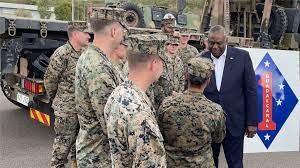U.S officials are leaving Australia feeling emboldened following a nearly weeklong trip that also featured a visit to Papua New Guinea.
Defence Secretary Lloyd Austin’s ninth trip to the Indo-Pacific aimed to improve intensifying ties with Papua New Guinea by strengthening the government’s defense capabilities, and secure more ambitious plans for defense cooperation with Australia.
Speaking on the sidelines of multiple meetings with Australian defence officials, U.S officials said the work, especially discussions in Brisbane for the 33rd annual Australia-United States Ministerial Consultations, paid off.
“The U.S-Australia alliance is stronger than it has ever been,” a senior U.S defence official said, previewing Saturday’s announcement of new defense initiatives with the Australian government.
Those initiatives include infrastructure improvements to a series of air bases across northern Australia, increased deployments of U.S forces and capabilities to Australia on a rotational basis, and plans to have Australia start manufacturing precision guided missiles and ammunition, the types of which have been in high demand in Ukraine.
Beyond those plans, however, U.S and Australian officials have emphasised the closeness of the alliance. U.S officials have repeatedly referred to it as “unbreakable,” while Australian Foreign Minister Penny Wong called the U.S Australia’s “vital ally.”
The U.S “is our closest global partner, our closest strategic partner,” Wong said following Saturday’s AUSMIN consultations, adding the relationship is now “about operationalising our alliance to ensure peace, stability” in the Indo-Pacific region.
To emphasise the close ties, Austin and Australian Defence Minister Richard Marles on Sunday flew on the U.S Defence Department’s jet – a militarised Boeing 747 – from Brisbane to Townsville, Australia, to visit troops taking part in Exercise Talisman Sabre.
The bilateral exercise is the largest joint U.S-Australian exercise, this year involving 30,000 troops, including those from 11 other nations. Some of those other countries, including Papua New Guinea, Fiji and Tonga, are taking part for the first time.
“What becomes manifestly clear … is a sense of team and shared vision between the countries participating,” Marles said, addressing a collection of troops from multiple countries.
“Relationships which are being built and created and which will endure when this exercise comes to an end,” Marles added, before mixing with the troops. “Countries, participating in Talisman Sabre are building a connectedness with each and [in] the way in which we go about our work which enhances the collective security of the Indo-Pacific region.”
Austin was no less effusive.
“I’m proud, I’m really proud that we have 13 countries participating in this year’s exercise who share that common vision,” Austin said.
“You’re bolstering deterrence by building capability,” he said. “You’re practicing logistics interoperability under realistic conditions so that we can improve combined capabilities, as well as our responses to a range of potential contingencies.”
One of those scenarios is a potential Chinese invasion of Taiwan.
Chinese President Xi Jinping has publicly ordered his armed forces to be ready to reunite Taiwan with China by force by 2027.
U.S intelligence officials have said it is not clear whether Xi will order such an invasion — the latest intelligence continues to suggest he would prefer not to use force — but U.S military and defense officials have said regardless of Beijing’s actual plans, the U.S and its allies must be ready.
There are likewise concerns about China’s ever more aggressive military posture, in the air and on sea, across the Indo-Pacific.
Australian military officials said some of the necessary capabilities, such as the ability to effectively communicate across militaries and platforms, and efforts to cut through the fog of mis- and disinformation, have been key aspect of the current exercises.
Some analysts also say that the developments over the past several days, and the series of new agreements, will bolster the ability of key U.S partners to push back against China, if necessary.
“Today, Australian leaders lack a way to militarily threaten or retaliate against China if Beijing were to commit acts of aggression against Australia,” said Bryan Clark, a senior fellow at the Washington-based Hudson Institute.
“For example, China is likely to mount ‘gray zone’ operations against Australia as Chinese leaders attempt to expand their military’s reach and influence across the Western Pacific,” he told VOA by email. “If Australia cannot threaten to fight back, China could escalate the scale and intensity of harassment or begin intruding on Australian territory, as China has already done to Japan, the Philippines, and Taiwan.”
But following this most recent visit, U.S officials involved in the talks with America’s Pacific partners are encouraged by what they see.
“There is a shared regional vision of a free and open Indo-Pacific,” a second senior defense official told reporters, briefing on the condition of anonymity.
“It is not just the United States,” the official said. “You hear it from countries throughout the Indo-Pacific, big and small, that there are certain principles, certain precepts that they believe are important and valuable and [that] undergird stability in the region.
SOURCE: VOA/PACNEWS














